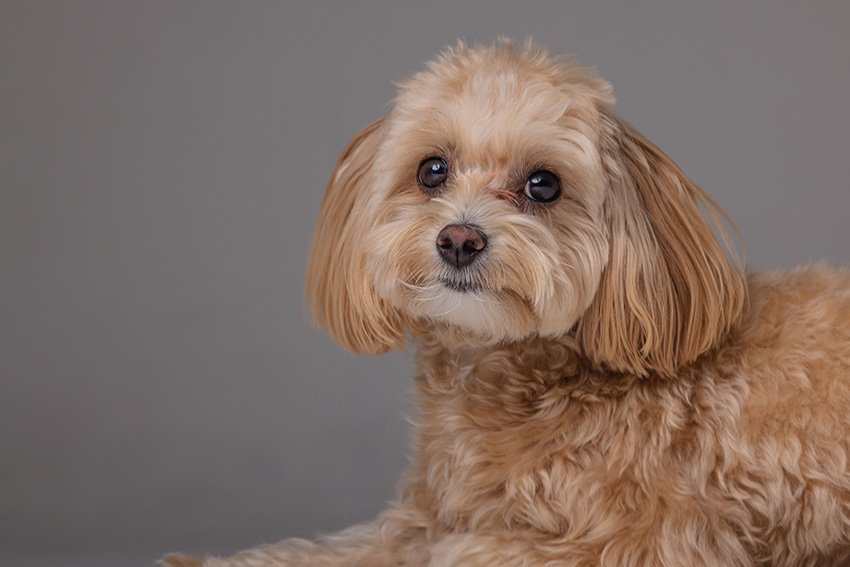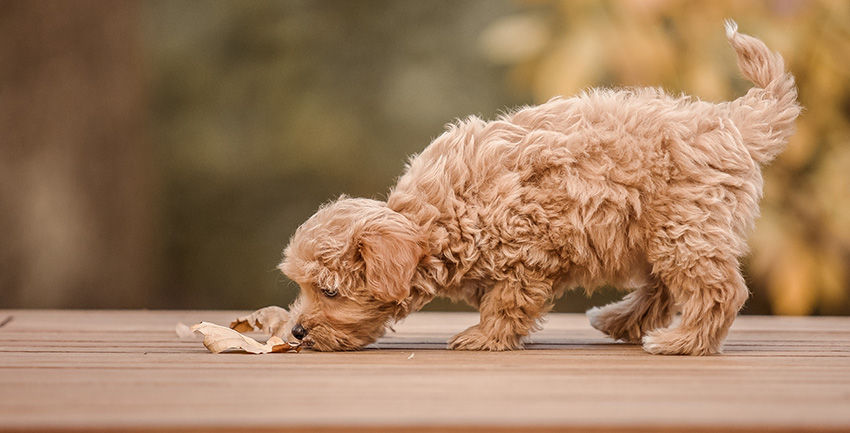As a so-called hybrid dog, the Maltipoo is not a recognized dog breed. Nevertheless, the cross between the Poodle and Maltese enjoys great popularity and so the fuzzy Maltipoo will also delight you with its friendly and lovable nature.
What is a Maltipoo?
The Maltipoo is a crossbreed between a Poodle and a Maltese, making it a so-called hybrid dog. The Maltese can be crossed with a toy or miniature poodle. The breed is becoming increasingly popular in the United States, as it is generally promoted as “robust” and suitable for allergy sufferers. However, the largest canine organization (FCI) does not officially recognize it.
Breed Overview
GROUP: Toy
HEIGHT: up to 14 inches
WEIGHT: 7 to 22 pounds
TEMPERAMENT: Obedient, cheerful, friendly, curious
COAT AND COLOR: curly, long, medium coat, black, blue, brown / chocolate / liver, cream, fawn, gold / yellow, gray, red, white
HYPOALLERGENIC: Yes
LIFE SPAN: 10 to 13 years
Character and Temperament
Typically, the Maltipoo exhibits the traits of its parent breeds:
- Owners and breeders describe it as a cheerful, curious, lively, and trainable dog.
- With good socialization, this small breed gets along well with other dogs, other animals, and children.
- If you engage with them, Maltipoos often become loyal, friendly, and affectionate companions, seeking and valuing your connection at all times.
TiP:
Towards strangers, the Maltipoo tends to be more reserved, and the breed may exhibit a certain tendency to bark. Additionally, it should be noted that contrary to common claims, not only the positive traits of the parent breeds are inherited. Despite the desire of many breeders and owners, hybrid dogs are by no means “superdogs.”
Training and Care

Especially considering the somewhat unpredictable character traits, it’s essential to consistently train your Maltipoo:
- Excessive harshness is not appropriate in training this small dog and could harm its long-term trust in you. A loving approach, on the other hand, lays the foundation for a trusting relationship.
- Consider yourself more as a confident and reliable partner alongside your Maltipoo.
- Pay special attention to a well-established recall, good impulse control, and ensure that walking on a loose leash works smoothly.
- In the puppy stage, take your Maltipoo outside every 2 to 3 hours to housebreak them. Also, teach them to settle down, and consider specialized courses in a good dog school for assistance.
- Just because your Maltipoo is a small dog does not mean they lack the need for exercise and outdoor activities. They are agile, eager to learn, and drawn outside even in rain and cold temperatures.
Grooming
If you neglect the grooming of your Maltipoo’s coat, it may become matted:
- It’s a misconception to think that non-shedding dogs don’t need grooming.
- Regularly brush and trim the wavy, curly, or curly coat of your Maltipoo.
- Occasionally bathe the small dog with dog shampoo to maintain its coat. However, avoid bathing too frequently to prevent stressing its skin’s natural protection.
Grooming also includes nail care, regular check-ups at the vet, deworming, vaccinations, and dental care. Start getting your Maltipoo used to nail trimming and regular brushing from a young age.
Nutrition
Provide your Maltipoo with high-quality dog food tailored to its individual needs for healthy development. Since both the Maltese and Poodle can be picky eaters, a mixed diet of dry and wet food is suitable for Maltipoos. Additionally, offer dental chews several times a week for dental care and stimulation, such as beef scalp.
Divide the daily food ration into at least two meals to ease your dog’s digestion. Avoid letting them become overweight or lacking essential nutrients. For this reason, futalis creates personalized dog food tailored precisely to your dog’s needs by our team of veterinarians.
The Perfect Family Dog for Beginners?
Although the Maltipoo is considered a “beginner dog,” do not underestimate the time and effort you must invest in caring for them:
- Even small dog breeds need regular exercise, mental stimulation, and sufficient social interactions. Your Maltipoo, if meeting the health requirements, is open to shared activities like tricks, scent work, basic obedience, Hoopers agility, or hiking.
- Maltipoos are not suitable as guard dogs that more or less do their own thing. They love being with their human companions. If you have to leave a Maltipoo alone for more than 4 to 6 hours daily (after the initial puppy adjustment period, during which you gradually acclimate your puppy to being alone), we recommend considering a different breed.
- If you have children, the companion dog can become an excellent playmate, provided your children also allow them moments of rest.
- While the Maltipoo is a small dog that can adapt to limited space in a city apartment, they still need immediate access to a grassy area for bathroom breaks.
- Don’t just walk the hybrid dog around the block; let them fulfill their canine needs. Both large and small dog breeds need ample space and opportunities to run and sniff, such as in the woods or fields.
- In general, the Maltipoo is suitable for beginners. However, there is always a certain risk of unforeseen and subsequently burdensome developments with hybrid dogs.
Maltipoo for Allergy Sufferers?
Breeders often claim that Maltipoos and other hybrid dogs like the Golden or Labradoodle are suitable for allergy sufferers:
- Hybrid dogs indeed shed significantly less than other dogs, but they still produce dander and saliva that can trigger allergic reactions.
- It cannot be definitively stated, based on current knowledge, that individuals with allergies can confidently acquire a crossbreed with a Poodle.
- If you have allergies, we strongly advise testing your reactions to the puppies at the breeder’s multiple times. Until you can be 100% certain that the selected dog does not trigger allergic reactions, you should refrain from bringing a puppy into your home.
History and Origin
Breeders in the USA have been breeding Maltipoos since the 1980s. The idea of crossing various dog breeds with a Poodle to create hypoallergenic dogs was not new at that time. This concept originated in Australia, leading to the creation of the Designer Dog Labradoodle.
Usually, Toy or Miniature Poodles are used to produce a Maltipoo. However, Poodles are not lap dogs. They were historically used as working dogs in hunting waterfowl, both in water and on land. The Maltese, on the other hand, has always served as a companion dog, exhibiting minimal hunting instincts. The contradictory traits of the parent breeds ultimately make it challenging to predict the character and temperament of Maltipoos.
Puppies

Characteristics
Since the Maltipoo is not officially recognized as a breed, there is no standardized breed standard.
Nevertheless, a few relatively consistent breed characteristics can be mentioned:
- The size of the small dog ranges from 12 to 14 inches in shoulder height.
- Their weight varies between 7 to 22 pounds.
- The size and weight are primarily determined by the Poodle variety (Toy, Miniature, or Standard Poodle) with which the Maltese is crossed.
- Since the Maltese is always white, the coat color of the Maltipoo is influenced by the Poodle. As a result, it can be quite diverse: cream, apricot, brown, black, gray; spotted and two-toned variations are also possible.
- The eyes of the Maltipoo are usually round and dark.
Diseases
Breeders and dog owners often describe the Maltipoo as a robust dog. However, the health of the parent animals and a responsible breeder are crucial for potential robustness. A crossbreed between two breeds is not inherently healthier.
Patellar Luxation:
Patellar luxation refers to a displacement of the kneecap. This condition is known to cause lameness in your Maltipoo. The kneecap jumps out of its natural position, affecting its normal range of motion. Small breeds like the Bolonka Zwetna, Papillon, or Chihuahua are particularly affected.
Other Known Illnesses and Genetic Diseases:
✔ Skin Diseases
✔ Eye Diseases
Buying a Maltipoo
If you have decided on a Maltipoo, consider the following aspects before bringing one into your home.
Discuss the following questions with your family beforehand:
- Do I have enough time to take care of a dog and provide sufficient exercise and stimulation multiple times a day?
- Do I have the financial means to care for a dog for the next 10 to 15 years (including not only the costs of acquisition and initial equipment but also expenses for veterinary care, insurance, taxes, possible surgical costs, etc. – an average dog’s life costs between 12,000 to 20,000 dollars)?
- Can I ensure the care of my Maltipoo if I am unavailable, sick, or on vacation?
- Am I aware that a dog may create mess, have diarrhea and vomiting, or experience other health issues, and that I need to support them?
- Do dog ownership and, in particular, the needs of a Maltipoo align with my lifestyle, and am I willing to spend a lot of time with them and train them consistently?
Breeders
Breeds recognized by the FCI and bred through a VDH-affiliated club must meet numerous requirements for breeding:
Trained examiners from the breeding association and veterinarians usually assess the temperament and health of parent animals.
Since the Maltipoo is not a recognized breed, breeders are not subject to the usually challenging requirements, and there is no authority obliging them to prove the health of the parent animals.
Be especially cautious when selecting breeders of hybrid dogs.

- Ask to see the breeding facility, the mother dog, and health certificates.
- The mother dog and puppies should be clean and well-maintained, have sufficient space and toys, and be open to visitors.
- Avoid Maltipoo puppies that appear sick, hide, or are raised in a kennel without family contact and additional stimuli.
- A good breeder not only willingly provides information about their dogs but also supports you after the puppies are handed over and answers your further questions without reservations.
Additionally, you can give adult dogs – including Maltese or Poodles – a new home. Occasionally, breed clubs or animal shelters may, albeit rarely, offer a Maltipoo in need. Simply inquire at your local animal shelter and schedule a visit.
How much does a Maltipoo cost?
The cost for a Maltipoo from a reputable breeder with papers ranges from approximately 1,500 to 2,000 dollars.
Disadvantages
To summarize for the Maltipoo: The crossbreeding of two very different dog breeds is not without its challenges:
- Some breeders and dog owners exaggerate the reputation of hybrid dogs, drawing potential buyers’ attention to purely positive aspects. Always be skeptical of such obvious marketing strategies, as Maltipoos cannot live up to all promises, and it is equally likely that the parent animals may (only) pass on their negative traits.
- The nature and character of a Maltipoo remain uncertain variables, even with consistent training.
- Maltipoos are not inherently healthier than other dogs. The lack of official breed recognition and associated regulations should make you particularly vigilant.
- With a Maltipoo, you cannot participate in official competitions or dog shows.
- Be aware that a hypoallergenic Maltipoo simply does not exist.
- If you are more of a laid-back person, the regular grooming of their coat might become a bit overwhelming.


